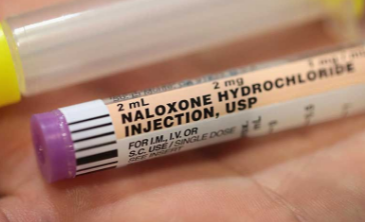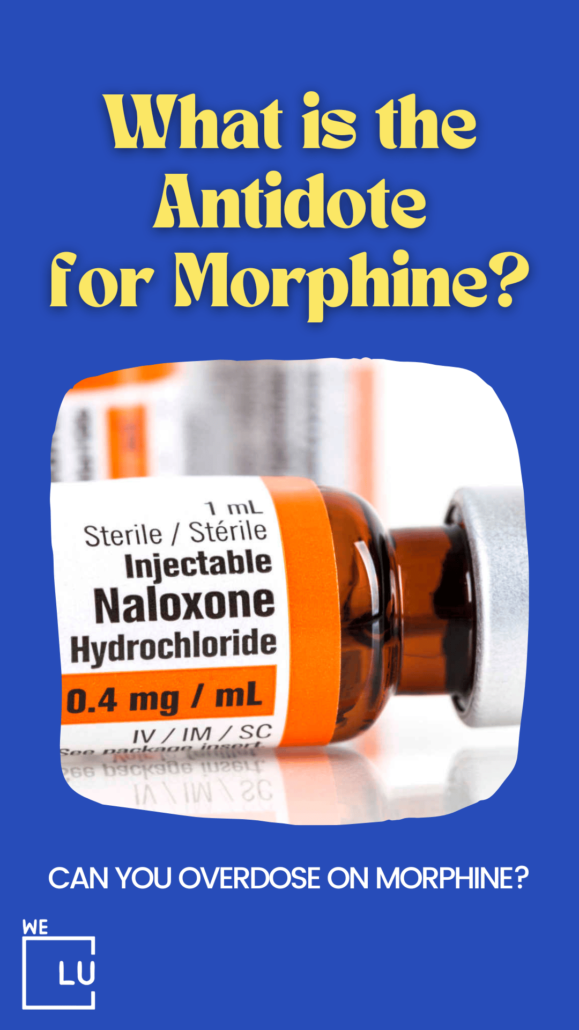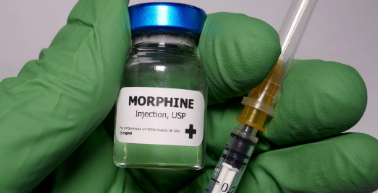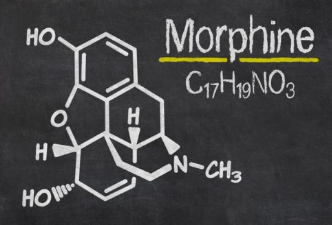Antidote for Morphine Sulfate. Can You Overdose on Morphine?
Morphine is an opioid analgesic prescribed for its effectiveness in relieving moderate to severe pain. It works because of the drug’s ability to change how the brain perceives pain. Regardless of how the drug is obtained (whether by prescription or illegally for recreation), morphine is highly addictive and becomes less effective over time. Morphine use is dangerous because it can be highly addictive. In addition, mixing morphine with other CNS (central nervous system) depressants, such as alcohol, can significantly increase the risk of overdose and even death.
Can you od on morphine? It is possible to overdose on morphine. accidental or Intentional overdoses can happen when taking this medication. This is especially true if a person takes more than what has been prescribed by a doctor or qualified healthcare professional. It usually takes about 200 milligrams of this drug to cause a morphine overdose (morphine overdose amount), though there have been extreme cases where drug overdose happens with as little as 60 milligrams. A standard dose of morphine is between 20 to 30 milligrams.
Some risk factors that predispose an individual to morphine overdose are:
- Individuals with severe medical and psychiatric conditions such as lung disease, depression, HIV, and liver disease
- Combining morphine with other CNS depressants, such as alcohol, benzodiazepines, or barbiturates
- Abuse of the drug
- Taking more than the prescribed amount of the drug
- Having an opioid use disorder
- Injecting opioids
- Resumption of morphine use after abstaining for a long time
Death following a morphine OD is preventable if the person receives essential life support and the timely administration of the drug naloxone. Naloxone is an antidote to morphine that will reverse the effects of an opioid overdose if administered in time. Naloxone has virtually no effect on people who have not taken opioids. Naloxone is available at most major pharmacy chains. Because opioid overdose deaths have spiked recently, naloxone is available without a prescription (and no questions asked).
Symptoms of Morphine Overdose
Like all opioids and opiates, morphine overdose symptoms fit into three broad categories collectively known as the opioid overdose triad. The three signs to look out for in a morphine overdose include the following:
- Comatose-like behavior: people may slip into a state of unconsciousness.
- Pinpoint pupils: one or both eyes may exhibit erratic behavior or have tiny pupils that do not react to light.
- Slower respiration rate: morphine OD can lead to pulmonary edema, filling the lungs with fluid, which is a leading cause of death for such an overdose. For this reason, monitoring breathing is essential.
More overdose warning signs that should never be ignored include limpness, the inability to speak, itching, pale skin, a bluish complexion on lips and fingernails, nausea, and confusion.
What Happens When a Person Overdoses on Morphine?
Most of the time, an overdose of morphine is accidental, and when it occurs, the drug will affect the entire body. Normal blood flow can be suppressed because of collapsed veins. As a result, the flow of oxygen can become limited, causing damage to the brain. A victim of a morphine overdose may collapse or have trouble breathing.
They may have a seizure or lose consciousness. Their fingernails and lips may turn blue, and they may begin gagging or be unable to swallow. You may not be able to wake them. It is a good idea to familiarize yourself with the indications of a morphine overdose, especially if you know someone who uses morphine and may be struggling with opioid addiction.
How Does Naloxone Work, and How Do You Use It?
Naloxone quickly reverses an overdose by blocking the effects of morphine. It can restore normal breathing within two to three minutes in a person whose breathing has slowed or even stopped due to a morphine overdose. More than one dose of naloxone may be needed when more potent opioids like fentanyl are involved.
Nearly 50,000 people died from an opioid-involved overdose in 2019. One study found that bystanders were present in more than one in three overdoses involving opioids. With the right tools, bystanders can act to prevent overdose deaths. Anyone can carry naloxone, give it to someone experiencing an overdose, and potentially save a life.
If you or someone you know is at increased risk for opioid overdose, especially those struggling with opioid use disorder (OUD), you should carry naloxone and keep it at home. People taking high-dose opioid medications (greater or equal to 50 morphine milligram equivalents per day) prescribed by a doctor, people who use opioids and benzodiazepines together, and people who use illicit opioids like heroin should all carry naloxone. Because you can’t use naloxone on yourself, let others know you have it in case you experience an opioid overdose.

Skip To:
- Antidote for Morphine. Can You Overdose on Morphine?
- Symptoms of Morphine Overdose
- What Happens When a Person Overdoses on Morphine?
- How Does Naloxone Work, and How Do You Use It?
- Morphine Addiction Statistics
- How Much Does Naloxone Cost?
- Treatment for an Opioid Overdose
- Can I Give Naloxone to Someone Who Has Overdosed on Morphine?
- What is the Antidote for Narcotics?
- What Is Narcan?
- Is Morphine Addictive?
- Symptoms of Morphine Addiction
- What are the Short-Term Effects of Morphine?
- What are the Long-Term Effects of Morphine?
- Morphine Addiction Treatment Near Me
Learn More:
Get Help. Get Better. Get Your Life Back.
Searching for Accredited Drug & Alcohol Rehab Centers Near You? Or Mental Health Support?
Even if you have failed previously, relapsed, or are in a difficult crisis, we stand ready to support you. Our trusted behavioral health specialists will not give up on you. Call us when you feel ready or want someone to speak to about therapy alternatives to change your life. Even if we cannot assist you, we will lead you wherever you can get support. There is no obligation. Call our hotline today.
FREE Addiction Hotline – Call 24/7Morphine Addiction Statistics
Opioid abuse has been increasing over the past ten years. Opioid abuse is rarely seen before the late teens, or early 20s. However, it can develop at any age. Among adults over 18, prevalence rates have been estimated at .37%. The male-to-female ratio for opiates other than heroin is 1.5 to 1. The highest prevalence rates are found in individuals aged 29 or younger (.82%), after which the disorder decreases until it reaches an estimated rate of .09% in those ages 65 or older.
10%
10% of the US population has abused an Opiate drug in their lifetime.
Source: NIDA
106%
The number of Morphine addicts admitted to the emergency room increased by 106% between the years 2004 and 2008.
Source: NIDA
60%
More than 60% of Morphine addicts admitted to getting the drug from friends or relatives.
Source: NIDA
Morphine Drug Fact Sheet
Morphine
Morphine sulfate is an opioid agonist indicated for the relief of moderate to severe acute and chronic pain where use of an opioid
analgesic is appropriate
Why is this medication prescribed?
Morphine is used to relieve moderate to severe pain. Morphine extended-release tablets and capsules are only used to relieve severe (around-the-clock) pain that cannot be controlled by the use of other pain medications.
Morphine extended-release tablets and capsules should not be used to treat pain that can be controlled by medication that is taken as needed. Morphine is in a class of medications called opiate (narcotic) analgesics. It works by changing the way the brain and nervous system respond to pain.
How should this medicine be used?
Morphine comes as a solution (liquid), an extended-release (long-acting) tablet, and as an extended-release (long-acting) capsule to take by mouth. The oral solution is usually taken every 4 hours as needed for pain. MS Contin brand and Arymo ER brand are extended-release tablets that are usually taken every 8 or every 12 hours.
Morphabond brand extended-release tablets are usually taken every 12 hours. Kadian brand extended-release capsules are usually taken with or without food every 12 hours or every 24 hours. Follow the directions on your prescription label carefully, and ask your doctor or pharmacist to explain any part you do not understand.
Toxicity
Morphine can potentially be a lethal medication when not used properly. It causes a host of symptoms related to depression of the CNS. Severe respiratory depression is the most feared complication of morphine in cases of overdose. Immediate injection of naloxone is required to reverse the effects of morphine.

Treatment for an Opioid Overdose
With essential life support and proper medical attention, the effects of an overdose can sometimes be reversed. However, treating overdoses as soon as possible after they occur is imperative. This is to give the person the best chance of recovery. It is also largely dependent on how severe the overdose is when determining the likelihood of making a full recovery.
Treatment for a morphine overdose is typically administered with a morphine antidote such as Naloxone. Healthcare professionals typically only administer this, but more people are beginning to carry a naloxone pen (nasal spray) for emergency use due to the ongoing opioid crisis.
Resuscitation or CPR may also be needed to treat a person who has overdosed on opioids. Specific cases may require treatments that can only be carried out by a doctor or trained healthcare professional.
How Much Does Naloxone Cost?
How much naloxone (morphine antidote) costs depends on whether or not you have insurance.
The average cost without insurance is:
- $45 for a multi-step injection
- $85 for a multi-step nasal spray
- $150 for a single-step nasal spray (Narcan)
Most insurance companies cover naloxone, though you may have a co-pay. Some states, like New York, offer naloxone coverage assistance programs that decrease your co-pay.

Get Your Life Back
Find Hope & Recovery. Get Safe Comfortable Detox, Addiction Rehab & Mental Health Dual Diagnosis High-Quality Care at the We Level Up Treatment Centers Network.
Hotline (877) 378-4154Can I Give Naloxone to Someone Who Has Overdosed on Morphine?
Yes. Families with loved ones who struggle with opioid addiction should have naloxone nearby, ask their family members to carry it and let friends know where it is. People should still call 911 immediately in the event of an overdose.
Naloxone is used more by police officers, emergency medical technicians, and non-emergency first responders than before. In most states, people who know someone at risk for an opioid overdose (including antipode for morphine sulfate overdose) can be trained to give naloxone. In addition, families can ask their pharmacists or healthcare provider how to use the devices.
Individuals who are given naloxone should be observed constantly until emergency care arrives. They should be monitored for another two hours after the last dose of naloxone is given to make sure breathing does not slow or stop.
What is the Antidote for Narcotics?
What is the meaning of an antidote? An antidote is a drug, chelating substance, or chemical that counteracts (neutralizes) the effects of another drug or a poison. Most antidotes are not 100% effective, and deaths may still happen even when an antidote has been administered. Most antidotes are of low toxicity, but serious adverse effects can result from excessive use and inadequate doses.
What is a narcotic? Narcotics are substances used to treat moderate to severe pain. Narcotics are like opiates such as morphine and codeine but are not made from opium. They bind to opioid receptors in the central nervous system (CNS). Narcotics are now called opioids.
Naloxone is a medicine that can temporarily reverse the effects of an opioid overdose (narcotics antidote); therefore, it can also be used as an antidote for heroin overdose. Even if it doesn’t help, it will not harm. If you use opioid drugs, always ensure you have a naloxone kit. Naloxone can be accessed through your local drug service or pharmacy.
What Is Narcan?
Narcan is a brand for Naloxone. Nasal Spray is a prescription product. However, every state has access laws or alternate arrangements that allow persons to obtain naloxone from a pharmacist without an individualized, in-person prescription. State laws vary for eligibility and dispensing authorization. Law allows licensed healthcare providers (including pharmacists) to make naloxone available to anyone at risk or in a position to assist someone at risk. Naloxone Access Laws (NALs) increase public access to naloxone and have been considered a promising solution to reducing opioid-related harm.
First-class Facilities & Amenities
World-class High-Quality Addiction & Mental Health Rehabilitation Treatment
Rehab Centers TourRenowned Addiction Centers. Serene Private Facilities. Inpatient rehab programs vary.
Addiction Helpline (877) 378-4154Proven recovery success experience, backed by a Team w/ History of:
15+
Years of Unified Experience
100s
5-Star Reviews Across Our Centers
10K
Recovery Success Stories Across Our Network
- Low Patient to Therapist Ratio
- Onsite Medical Detox Center
- Comprehensive Dual-Diagnosis Treatment
- Complimentary Family & Alumni Programs
- Coaching, Recovery & Personal Development Events
Is Morphine Addictive?
Morphine in any form can lead to addiction. Injectable morphine solution has become more widely used—and sometimes abused—as drug manufacturers prioritize other opioid pills, like oxycodone. Morphine, like other opioids, travels through your blood and attaches to specific receptors in your brain cells to reduce pain and boost feelings of pleasure.
But over time, especially if you have risk factors for opioid addiction, your body can become used to those feelings of pleasure even after the pain has passed. This can lead to morphine addiction. Morphine can be more addictive than less potent opioids, such as codeine. It is less addictive than heroin, oxycodone, heroin, and fentanyl. It’s about as addictive as hydrocodone.
Symptoms of Morphine Addiction
The following symptoms most often with morphine addiction are the following:
- Short-term physical effects: Nausea, dilated pupils, slowed breathing, sleepiness or lethargy, and sweats and chills.
- Long-term physical effects: Depression, severe constipation, erratic sleep cycles, body tremors, and kidney issues
- Behavioral changes: Withdrawal from others and activities, sudden lying and stealing, neglecting daily responsibilities, becoming highly irritated or aggressive

What are the Short Term Effects of Morphine?
As a Narcotic drug, Morphine is often abused for its pleasurable effects. Those suffering from chronic pain have the potential to abuse their medication, which increases their likelihood of developing a substance use disorder.
Common effects of Morphine include:
- Pain relief
- Euphoria
- Sleepiness or unusual drowsiness
- Calm feeling
- Reduced anxiety
- False or unusual sense of well-being
Any time a person uses Morphine without a prescription, it is considered abuse. Although it is a legal substance when prescribed, it is a heavily regulated one. Possession of Morphine without a prescription is a criminal offense, the degree of which varies based on the jurisdiction and the amount of the drug in possession.
World-class, Accredited, 5-Star Reviewed, Effective Addiction & Mental Health Programs. Complete Behavioral Health Inpatient Rehab, Detox plus Co-occuring Disorders Therapy.
CALL (877) 378-4154End the Addiction Pain. End the Emotional Rollercoaster. Get Your Life Back. Start Drug, Alcohol & Dual Diagnosis Mental Health Treatment Now. Get Free No-obligation Guidance by Substance Abuse Specialists Who Understand Addiction & Mental Health Recovery & Know How to Help.
What are the Long Term Effects of Morphine?
When morphine is used for a long time, it may become habit-forming, causing mental or physical dependence. Physical dependence may lead to withdrawal side effects if treatment is stopped suddenly. However, severe withdrawal side effects can usually be prevented by gradually reducing the dose before treatment is stopped completely.
Even those who do not experience morphine OD can suffer long-term physical consequences from morphine abuse. These effects can range from inconvenient to debilitating. If you have a loved one you suspect may be addicted to morphine, it is essential to talk to them about the full extent of the risks associated with drug abuse.

Long-term morphine abuse can cause dangerous physical harm and chronic health problems. These effects can include:
- Difficulty with thinking clearly.
- Chronic constipation, which can ultimately cause hemorrhoids, nerve damage, fecal impaction, and other bowel issues and damage
- Gastrointestinal bleeding
- Memory damage or loss
- Issues controlling impulses and other behavioral problems
- Hyperalgesia, which involves feeling the pain more intensely than previously
- Muscle tone loss
- Changes to the brain structure that can affect the overall function
- Difficulty recovering after suffering from an injury or a surgery
- Heartburn and damage to the esophagus from nausea or vomiting
- Oxygen deprivation as a result of consistent respiratory depression
- Damage to the cardiovascular system from blood pressure fluctuation and oxygen deprivation
- Liver and kidney damage
- Hormonal imbalances can trigger mood disorders, fertility issues, and a higher risk of cancer
Experience Transformative Recovery at the We Level Up Treatment Center.
See our authentic success stories. Get inspired. Get the help you deserve.



Start a New Life
Begin with a free call to an addiction & behavioral health treatment advisor. Learn more about our dual-diagnosis programs. The We Level Up treatment center network delivers various recovery programs at each treatment facility. Call to learn more.
- Personalized Care
- Caring Accountable Staff
- World-class Amenities
- Licensed & Accredited
- Renowned w/ 5-Star Reviews
We’ll Call You
Morphine Addiction Treatment Near Me
Morphine addiction is a chronic disease and should be treated like other chronic diseases. Like those, it should constantly be monitored and managed. Morphine is a type of opioid. Opioid addiction treatment is different for each individual. The main purpose of opioid addiction treatment is to help the person stop using the drug. Opioid addiction treatment can also help the person avoid using it again.
The body goes through specific symptom stages known as opiate withdrawal. The opiate withdrawal timeline varies from a few days to a few weeks, depending on the type of opioid used, how long it was used, and any other substances that may have been used in conjunction with opioids. Medically managed withdrawal opiate detox ensures the individual remains safe and stays as comfortable as possible.
Morphine Detox Treatment
The first step in treatment is medical detox. It will help you navigate the complicated withdrawal process but doesn’t address patterns of thought and behavior contributing to Morphine addiction. Various treatment approaches and settings can help provide the ongoing support necessary to maintain long-term sobriety after you complete detox.
Cravings are very common during detox and can be challenging to overcome. This often leads to relapse. Constant medical care provided during inpatient treatment helps prevent relapse. Clinicians can give the necessary medication and medical expertise to lessen cravings and the effects of withdrawals.
Morphine Withdrawal Treatment Inpatient
There isn’t one treatment approach or style that will suit everyone. Treatment should speak to the needs of the individual. Inpatient drug rehab and addiction treatment aren’t just about drug or alcohol use. the goal is to help the person stop using drugs like Morphine. Drug and alcohol rehab should also focus on the whole person’s needs.
Addiction is a complex but treatable disease that affects brain function and behavior. When someone or their family is considering different treatment facilities, they should account for the complexity of addiction and the needs of the individual. The objective of attending an inpatient drug and alcohol rehab center for addiction treatment is to stop using the drug and re-learn how to live a productive life without it.
Most people benefit from inpatient rehab after a full medical detox from drugs and alcohol. Inpatient drug rehab can last anywhere from 28 days to several months. Patients stay overnight in the rehab facility and participate in intensive treatment programs and therapy. Once someone completes rehab, their addiction treatment team will create an aftercare program, including continuing therapy and participation in a 12-step program like Alcoholics Anonymous and Narcotics Anonymous.
Psychotherapy
Many rehab programs will also have early morning classes or programs. Group sessions occur during inpatient rehab, as do individual therapy sessions. Family therapy may be part of inpatient rehab when it’s feasible. Alternative forms of therapy may be introduced during inpatient rehab, like a holistic therapy program, yoga for addiction recovery, or addiction treatment massage therapy.
Several different modalities of psychotherapy have been used in the treatment of mental health disorders along with addiction, including:
- Cognitive Behavioral Therapy (CBT) – is an effective treatment that involves changing both the patterns of negative thoughts and the behavioral routines which are affecting the daily life of the depressed person for various forms of depression.
- Dialectical Behavioral Therapy (DBT) – is a comprehensive mental health and substance abuse treatment program whose ultimate goal is to aid patients in their efforts to build a life worth living. The main goal of DBT is to help a person develop what is referred to as a “clear mind.”
- Solution-focused therapy is an approach interested in solutions that can be quickly implemented with a simple first step leading to further positive consequences.
Dual Diagnosis Treatment
Drug abuse and mental health disorders often co-occur. In many cases, traumatic experiences can result in mental health disorders and substance abuse. Dual diagnosis rehabilitation treats both of these issues together. The best approach for the treatment of dual diagnosis is an integrated system. This strategy treats both the substance abuse problem and the mental disorder simultaneously. Regardless of which diagnosis (mental health or substance abuse problem) came first, long-term recovery will depend mainly on the treatment for both diseases done by the same team or provider.
Medication Assisted Treatments (MAT)
Medication-Assisted Treatments (MAT) for substance use and mental health disorders are commonly used in conjunction with one another. This includes the use of medications and other medical procedures. During your rehab, the staff from your treatment facility will help you identify what caused your addiction and teach you skills that will help you change your behavior patterns and challenge the negative thoughts that led to your addiction. Sometimes, the pressures and problems in your life lead you to rely on substances to help you forget about them momentarily.
Please, do not try to detox on your own. The detox process can be painful and difficult without medical assistance. However, getting through the detox process is crucial for continued treatment. We Level Up provide proper care with round-the-clock medical staff to assist your recovery through our opioid addiction treatment program medically. So, reclaim your life, and call us to speak with one of our treatment specialists. Our counselors know what you are going through and will answer any of your questions.

Search We Level Up NJ “Antidote for Morphine. Can You Overdose on Morphine?” Topics & Resources
Sources
[1] Morphine: MedlinePlus Drug Information
[2] Morphine Addiction – We Level Up Treatment Centers
[3] Morphine Sulfate tablets label (fda.gov)
[5] Morphine And Alcohol, 1st Class Polydrug Abuse Rehab Center (welevelup.com)
[6] Morphine Antidote – StatPearls – NCBI Bookshelf (nih.gov)
[7] The Mechanisms Involved in Morphine Addiction and Morphine Antidote – PMC (nih.gov)